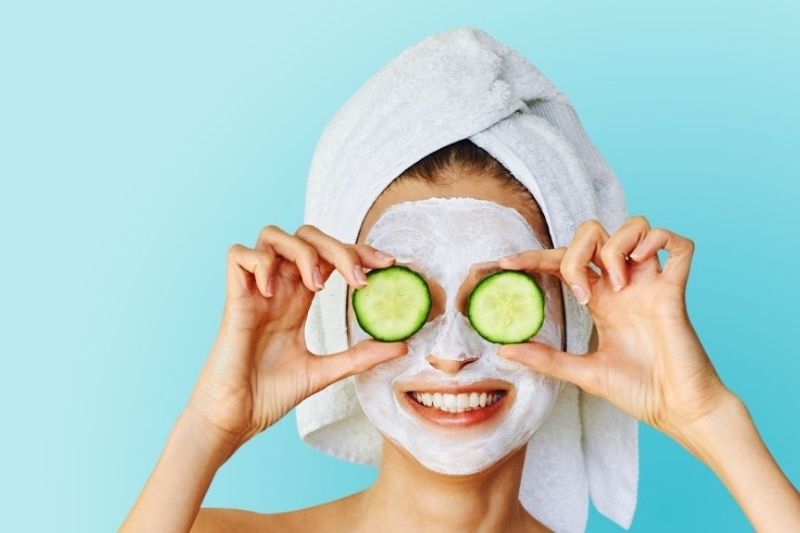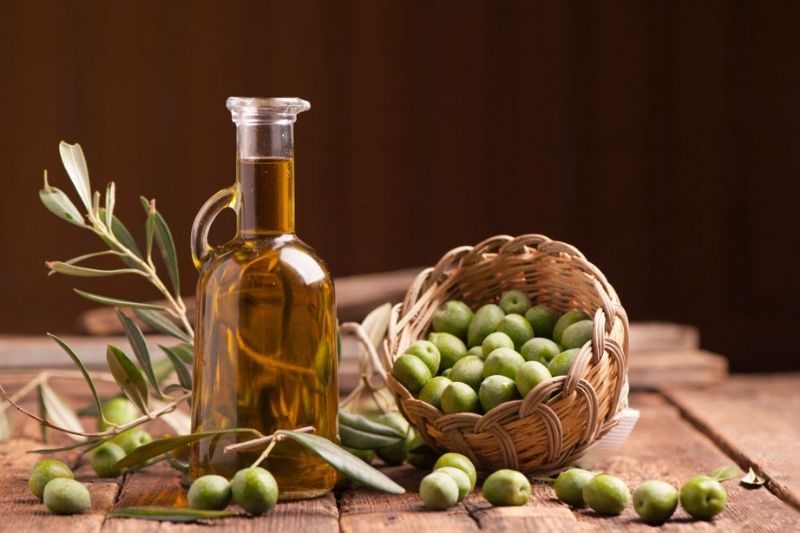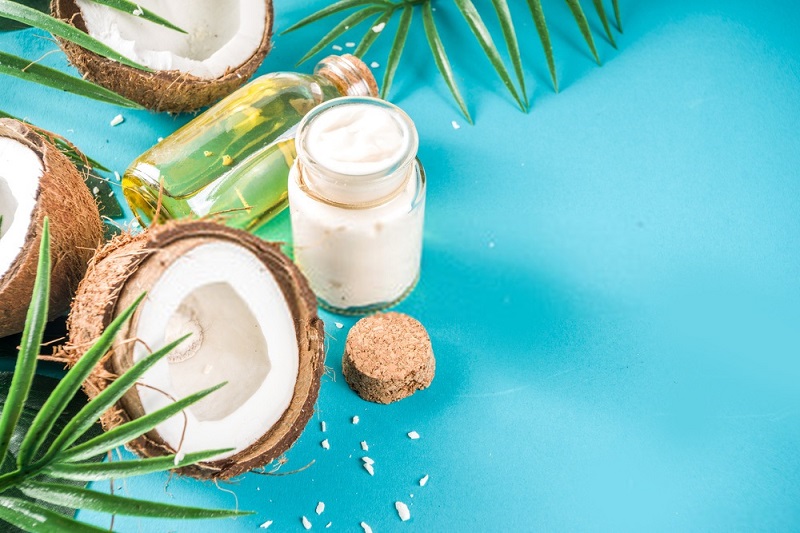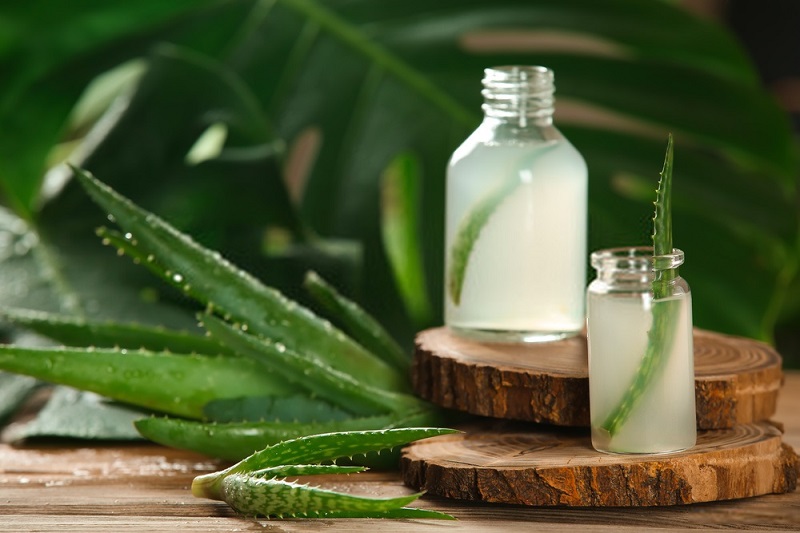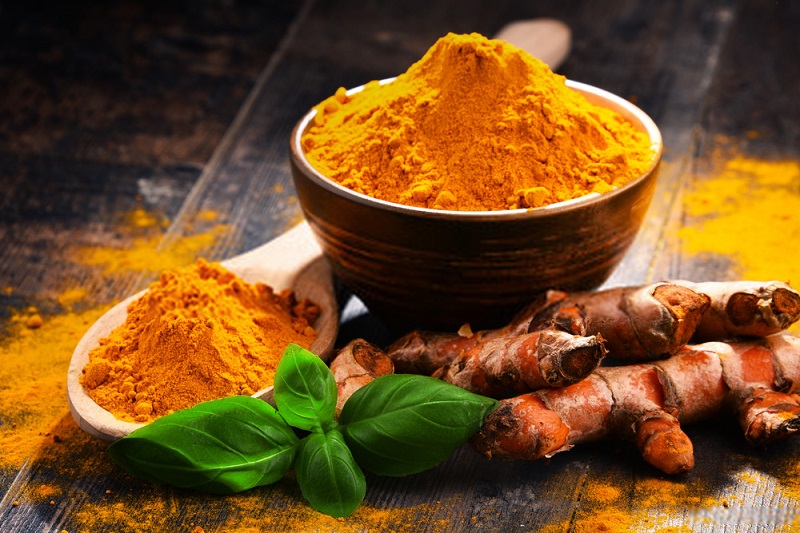Clay is made up of a mix of minerals and other substances, such as aluminum silicate, mercury, silver, iron, gold, lead, tin and copper. They allow the clay to perform a deep purifying action that allows you to fight skin imperfections, relieve itching and dandruff involving the scalp. Not only that, the main properties also include the capabilities:
- Anti-oxidant and anti-aging: One of the most important benefits of clay mask is that it allows a faster and more effective cell renewal
- Anti-inflammatory and soothing: When used on pimples, redness and skin irritations, it relieves pain, soothes the area and reduces swelling
- Firming: By stimulating cell renewal, the skin appears more toned and elastic
- Toning and stimulating for blood circulation: If taken in the form of supplements it promotes the proper functioning of the cardiovascular system
- Stimulant for the production of collagen: One of the most popular benefits of clay mask is that if used on the skin it performs a real booster function.
Cosmetic companies mainly use clay in formulas for face masks and hair, however, there are also clay-based face and body cleansers and creams that perform a correct sebum-regulating action that allows acne sufferers to keep pimples and impurities under control.
General information about clay
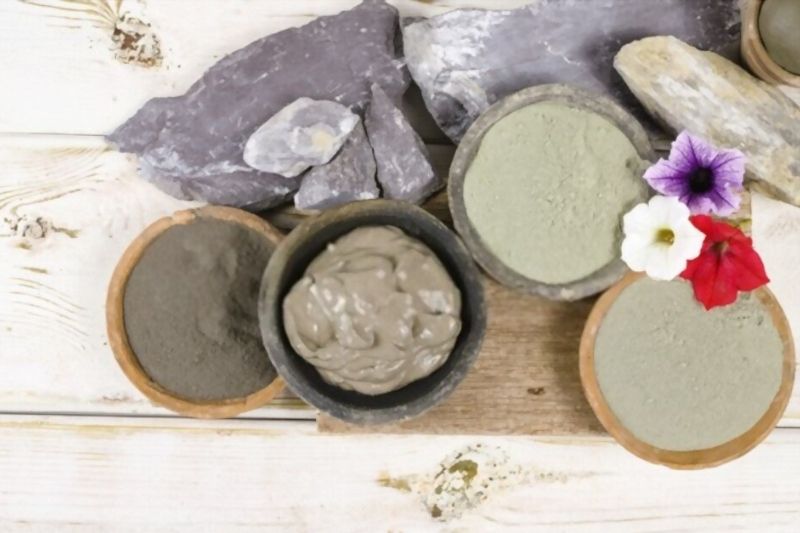
Clay, which as we know is a natural substance composed mainly of minerals, is obtained from rocks and sediments and is used in the cosmetic field for numerous purposes. Although the most common and known use of clay is linked to beauty masks, it is actually also used in many other hygiene products such as shampoos, shower gels, toothpastes and creams.
Clay is found in its natural state in numerous varieties and colors. The best-known types in addition to white clay are green, red, yellow and Rhassoul. Each of them differs for a particular chemical composition and for specific qualities and fields of use.
Green clay
This type is undoubtedly the best known and most used in the world of natural cosmetics. Its color depends on the presence of 50% silica and 14% aluminum. Its alkaline pH and the anti-inflammatory and detoxifying properties that characterize it, make it particularly suitable for treating numerous skin problems and, in particular, acne, eczema and imperfections.
Mixed with water, green clay generates a creamy product ideal to be applied on the face to absorb, thanks to its detoxifying properties, the impurities that are deposited there. Use the latest discount vouchers to purchase green clay online and earn extra discount.
Red clay
The reddish color mainly depends on the high concentration of trivalent red iron present inside. Already from ancient Rome to treat joint pain and in the field of cosmetics. Today red clay in the home is used for the realization of DIY face masks. In fact, one of the main benefits of clay mask of this type is its ability to soothe irritations, relieve dermatitis and skin redness.
Not only that, it can also be used in products for the treatment of bruises, bruises and hematomas since it also allows to reduce swelling and pain. Similarly, using a small amount of red clay on the toothbrush it is possible to act directly on gingivitis or inflammation of the mouth to decrease its intensity and eliminate bacteria
White clay
Its light color, as in the case of gray clay, depends on the massive presence of siliceous compounds (up to 60%). The first white clay deposit was discovered in the Kao-Ling region of China and for this reason it is also known as kaolin. Thanks to its particular composition, it is used in the treatment of the skin and scalp. Specifically, face and hair masks are made with white clay, scrub, toothpaste and much more. Thanks to its delicate purifying action, it is ideal for treating more sensitive skin and irritated or red areas
Yellow clay
Among the most particular and rare, it owes its color to the strong presence of iron and copper. This type of clay is particularly known for its refreshing and soothing properties. In fact, cosmetic companies use it many times for the creation of creams and gels to be used in case of tired and swollen legs, back and joint pains. Also ideal for sensitive skin, to purify and refresh the skin in a delicate way, to relieve redness from eczema or rubbing.
In this article, we’ll discuss the benefits of clay mask of all types and tell you how to use the various varieties to take care of your skin.
The properties and benefits of clay mask made from white clay
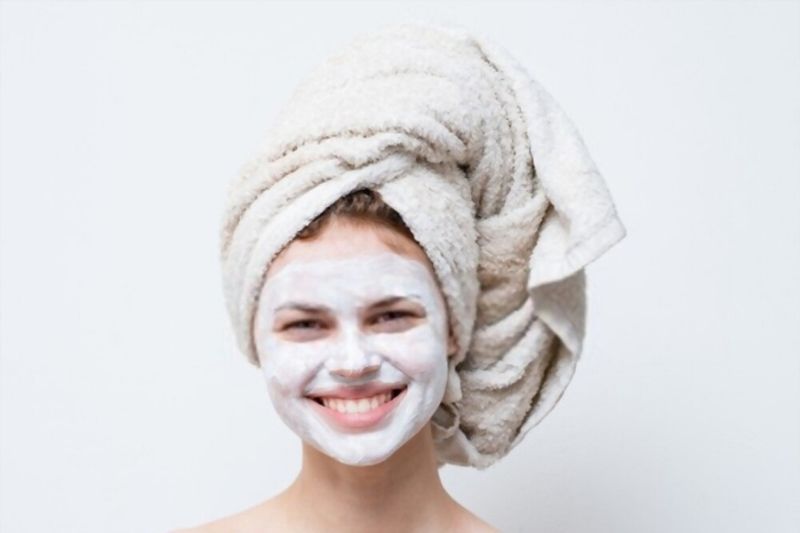
White clay, also known as kaolin, is ideal for those who want to take care of their beauty with natural cosmetics. Its action, sweeter and lighter than that of other types of clay, is also suitable for the driest and most delicate skins.
Its exfoliating action allows you to remove dead cells from the skin surface and thus promote the softness and regeneration of the skin. White clay boasts lightening properties and its use is therefore indicated both on the skin and, as we will see later, on the teeth. By applying a very simple purifying face mask with white clay you will get a smooth, healthy and radiant skin.
Performing an important sebum-regulating function, this clay is useful for cleansing oily skin, to eliminate blemishes such as acne and blackheads as well as to combat dandruff. It also shows healing properties on the skin and is therefore valid for counteracting cracking and stretch marks. White clay is also ideal for the care of dry, dull hair that tends to break: it gives volume, strength and resistance.
Among the various types of existing clay, the white one is the finest and most suitable for internal use. By dissolving a teaspoon of clay in a glass of water it helps to counteract swelling, stomach acid, expel toxins and improve intestinal motility. If used in this way, however, it is necessary to avoid the use of plastic or metal spoons as well as glasses made of thin materials such as crystal. Looking to purchase white clay infused skincare products? Use the relevant deals coupons on Just Beauty Guide to earn additional discount.
All the benefits of clay mask made from white clay
Preparing a beauty mask with white clay is really simple. Just add a little water and two teaspoons of clay to a bowl until a homogeneous and creamy mixture is formed. The mixture thus obtained should be left to act on the skin for about twenty minutes and then rinsed. The same remedy can also be applied to the hair.
The white clay, being very delicate, can also be used on the sensitive skin of children: it is often found in soothing, refreshing and hypoallergenic talcum powder. The white clay is also an effective natural odor absorber; it is in fact able to neutralize bad smells and for this reason it can also be used inside the refrigerator or in the environments where you cook.
Given the antiseptic and bleaching virtues enjoyed by this clay, it is also used for the production of natural toothpastes with a remarkable whitening power. It not only promotes cleaning of the teeth and the removal of bacteria but is also able to fight bad breath and ensure a dazzling smile.
Finally, we cannot forget the valuable strengthening action that white clay exerts on the hair. It is mainly used in shampoos for fragile and oily hair as it helps to improve its strength and to counteract dandruff.

Amazing benefits of clay mask made from green clay and the recipes to try
Green clay is a natural remedy from the many beneficial applications. Since ancient times it has been used for the preparation of compresses suitable for skin care. Here are a few easy-to-make recipes.
Green clay face mask
Making a face mask is one of the most frequent uses of green clay. First of all, it is necessary to prepare the base of the mask, to which different ingredients will then be added depending on the type of skin. For example: mallow tea for dry skin, lemon juice for oily skin and lavender essential oil for normal skin. The base mask is obtained by mixing water at room temperature with the clay.
Green clay facial cleanser
To get a completely natural facial cleanser, you can mix 1 teaspoon of green clay, 1 tablespoon of aloe gel, 1 handful of ground almond or almond flour, 2 drops of lavender essential oil and a few drops of tonic for the eco-bio face, in order to obtain a rather solid compound. Just peel off a piece of it at the time of use, mix it with tap water on the palm of your hand and use it on your face as if it were a rinse-off cleanser or normal soap.
DIY green clay mask
Do you like to create customized cosmetics for yourself? Well, you can also do it with green clay: nothing could be simpler!
Just combine powdered green clay in a bowl with lukewarm water until you get a homogeneous mixture. To enhance the benefits of clay mask, you can add amla powder or nettle powder.
Amla, a powder extracted from an Indian plant that you find in herbal medicine, is a powerful regenerator suitable for skin and hair. How does it work? It brightens the complexion and purifies, gives light to the hair, prevents its loss and fights dandruff. Nettle powder, on the other hand, is ideal for fortifying hair.
How often should the green clay mask be applied? Once a week it is ideal for both face and hair.
Recipes for green clay masks
For a basic mask take 1 glass of green clay, 1 tablespoon of honey, 1 teaspoon of sweet almond oil (or alternatively EVO oil) and 1/2 a glass of water. In a cup containing mineral water, dissolve the honey, add the oil and homogenize everything. Then gradually add 1 glass of clay, continuing to mix vigorously until you get a smooth and shiny cream.
For normal skin, add half a teaspoon of wheat germ oil to the basic mask and mix everything together. If you like, you can add 1 to 3 drops of lavender essential oil. Keep on for 10 minutes and then rinse.
If you have dry skin, add 2 tablespoons of infusion of mallow leaves & a few drops of borage oil to the basic mask and mix everything together. If you like, you can add 1 to 3 drops of sandalwood essential oil. Keep on for 5 minutes and then rinse.
For oily skin, add 1 tablespoon of freshly squeezed lemon or grapefruit juice to the basic green clay mask and mix everything together. If you like, add 1 to 3 drops of lemon essential oil. Keep on for 10 minutes and then rinse.
How is the green clay mask applied?
When you decide to apply the green clay mask on your face, first you have to moisten your face and apply the product in abundant quantity so that it does not dry out immediately starting to pull the skin. At this point wait about 10/15 minutes and then start rinsing with warm water. You don’t have to wait for the mask to be completely dry.
Contrary to popular belief, the mask should not be kept on for too long, even if you have oily skin, as it could irritate the skin. Do you want a tip? Add some honey to the product to keep the mask moist for longer. At the end of the treatment, apply a moisturizer to help restore the hydrolipidic film of the skin that will have been affected by the mask.
Benefits of Rhassoul Clay
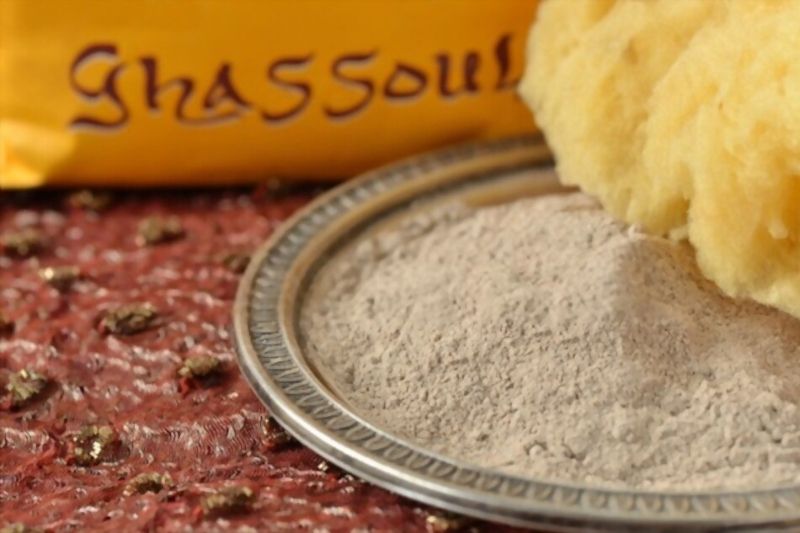
The ghassoul (or rhassoul) is a clay of volcanic origin. It is extracted from underground mines in the Atlas Mountains, in northwestern Africa. After being extracted, it is washed to remove impurities and then left to dry in the sun, before being reduced to powder.
It has been known for centuries and is mainly used in North Africa and the Middle East. It can be used alone or found as an ingredient in hair and skincare products.
Ghassoul clay: the benefits of clay mask on face, body and hair
First of all, ghassoul clay is a fully biodegradable mineral product, so the first to benefit will be the planet. However, there will also be many benefits of clay mask, for the skin and hair of those who choose to use it.
The benefits will likely not show immediately, but over time. This is because when you switch from products containing silicones, petrolatum and other chemicals to natural skin care products, your skin and hair may initially appear a little drier and / or less shiny, but over time, using natural products pays off; it is only a passing phase, in the end the hair and the skin will be healthier and more beautiful than ever.
The ghassoul is rich in minerals, in particular silicon and magnesium and purifies without attacking. On the skin of the body and face, it performs a sebum-regulating, soothing and slightly moisturizing action. It is therefore particularly suitable for impure and combination, acne-prone skin.
How to use ghassoul clay?
The easiest way to use ghassoul clay is to buy soaps, cleansers, shampoos, masks, or other products that contain it; if you opt for this solution, read the INCI very carefully to make sure the ghassoul is at the top of the ingredient list. Those who love to try their hand at the preparation of personal care products or want to make a first attempt in this sense, can buy it pure. Do-it-yourself at the beginning can involve some difficulties but it is only a matter of time and habit because then it gets carried away. It is not complicated.
Ghassoul is a very fine brownish-green powder. The preparation operations, as for all clays, should not be carried out in metal containers as the product could absorb metal particles which would then release on our hair or on our skin and this is never advisable. The preparation must therefore be carried out in glass, wood and / or terracotta containers, using a wooden spoon to mix and / or a brush of those that are generally used to apply the dye on the hair.
How to use ghassoul clay on face and body skin?
The mixture is prepared as described above. Just water and ghassoul, or by adding one or two tablespoons of honey or a few drops of essential oil, depending on your needs. Honey makes the preparation more moisturizing. The compound obtained can be used as a detergent or as a mask. As a cleanser, apply it to moistened skin on the face and body, massaging well in order to also have an exfoliating effect. If you want to increase the scrub effect, the horsehair glove can be used on the body. Rinse thoroughly and then applies a moisturizer.
As a mask, moisten the skin, apply and leave on for about ten minutes; remove with plenty of water with the help of a sponge. This mask is mainly used on the face and is effective in removing impurities, including blackheads, but it is also indicated on the rest of the body, especially on the back when there is a tendency to develop acne and oily skin in that area.
Uses of other types of clay

The other types of clay are a little more difficult to find available in herbal medicine. However, let’s see some possible uses:
Pink clay: Given its nourishing power, masks can be made for face and dry hair, toothpaste and can be used as it is instead of talcum powder for children. You can also add a few tablespoons to hot water before bathing.
Red clay: With this variant you can make face and body packs especially in case of dermatitis or skin irritation. You can also add 2 or 3 tablespoons directly into the bath.
Yellow clay: This earth is also excellent for making face masks, simply by combining it with water and essential oils of your choice.
Gray clay: Thanks to the high presence of silicon, this variant can be used as an effective anti-inflammatory in case of joint and muscle pain as well as as a mask for acne prone skin. There are those who also use it internally as a detoxifier instead of the more well-known ventilated green clay.
Blue clay: Particularly suitable for oily skin, it can be useful for making masks in areas of the body where pimples appear. Also excellent for making clay compresses against pains.
Conclusion
The clay mask is one of the most versatile natural skin care products, which lends itself to numerous applications and uses. It has been used for the well-being of the skin since ancient times, especially as a purifying face mask and for compresses to be applied all over the body.
However, the clay mask is not exclusively a dermo-aesthetic treatment. Thanks to its particular properties, in fact, it is suitable for the treatment of some skin problems, such as wounds, acne, seborrhea, erythema and dermatosis.
Its benefits are known above all in relation to impure, combination or oily skin, as well as its draining action against the most fought imperfection ever, cellulite. Not many, on the other hand, know clay for its anti – wrinkle properties which can benefit both younger skin, as a preventive function, and mature skin.
